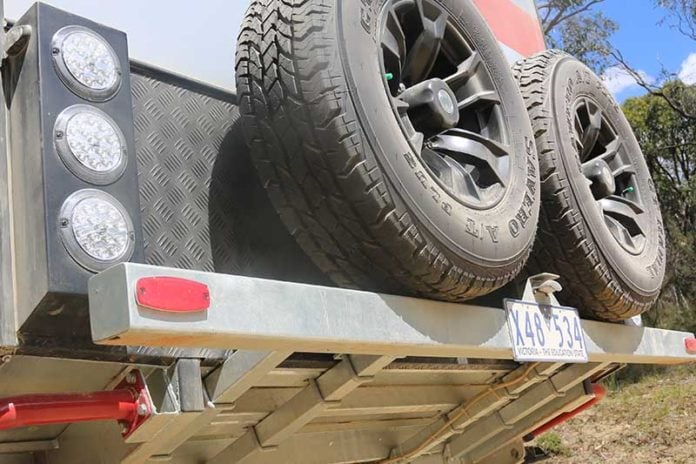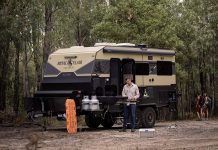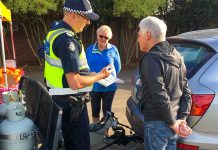Why don’t all caravans have reversing lights? Caravans are large, visually obstructive objects. Therefore, anything that gives the driver an advantage when reversing, especially at night, should be welcome.
I, for one, have difficulty understanding why the relevant standard, as defined by the Vehicle Standards Bulletin 1, 13.13 Reversing Lamps, stipulates that reversing lights are optional equipment.
Think about it. The law says the tow vehicle must be fitted with reversing lights. But the big, heavy object behind it? Nope. This makes no sense. Logic suggests, in fact demands, that the reversing lights on the tow vehicle will be minimally visible with a caravan hooked up. Their ability to light the way for the person in the driver’s seat is hugely compromised, if not downright irrelevant.
But my caravan has a reversing camera, you might say. In my view, the installation of a reversing camera does not mitigate the logical need for reversing lights on caravans.
Let me be clear: I’m not having a dig at caravan manufacturers, who are only following the law. Rather, I’m questioning a standard that makes optional something that should clearly be mandatory.
And there’s another safety aspect involved, that of people around the caravan, such as distracted children or pedestrians. Perhaps a visual warning – clear white lights at the rear of the van indicating the caravan is about to start backing up – would give these bystanders the presence of mind to move to safety.
WHAT THE LAW SAYS
VSB 1 is clear. To quote:
13.13 Reversing Lamps
Presence: Optional on all trailers (emphasis added).
Number: 1 or 2 lamps must be fitted on all trailers with a length less than 6000mm.
2 lamps must be fitted on all trailers with a length greater than 6000mm.
Arrangement: At the rear.
A minimum height of not less than 250mm from the ground; and maximum height of 1200mm from the ground.
Electrical connections: The lamps light up when reverse gear is engaged on the towing vehicle.
RETROFITTING
Motorhomes have reversing lights, no? And the last time I checked, the average 4WD and 18ft caravan had a combined length greater than any C class rig. Truck not only have reversing lights but buzzers that sound when ‘reverse’ is engaged to warn others that the vehicle is backing up. Is this not an acknowledgment that large vehicle/trailer combinations with limited visibility at the rear need an appropriate warning system for the safety of others?
Andrew Phillips of the RV Repair Centre and Coronet Caravans says that reversing lights can be retrofitted, though it’s not a particularly straightforward job. All of the pins in a standard seven-pin trailer plug are used for electrical connections such as brake lights and indicators, so fitting a wiring connection for reversing lights requires installers to swap to a 12-pin plug. But for new vans it can be problematic, considering all of the features they tend to be fitted with.
“If we were to wire a Coronet with reversing lights, we would have to rearrange our plug as all pins are used, and we have done this in the past,” Andrew told GoRV. “Don’t me wrong, we can definitely do it, but I would not say it’s straightforward. We have done our fair share of it in the past and I hope to do more of it in the future.”
The ‘rearranging’ of the plug would probably involve fitting an Anderson plug, he said.
I checked in with Roy Wyss, the owner of Queensland’s Sunland Caravan. His response was overwhelmingly in favour of reversing lights being mandatory caravan equipment.
“If I had my way, they would also have reverse buzzers,” he said.
GoRV contributors and long-time caravanners, Bruce and Marg Gow (also known as the Baby Boomers on the Road), are also strongly in favour. The tow an On the Move Grenade, which was fitted with reversing lights as standard.
“Once the van is hitched up, we have the same lights as the car, as in we have LED lights on the van that are linked to the reversing lights on the car,” Marg said. “We think all vans should have reversing lights – it seems like common sense. Knowing the movement of a van, especially when parking it, must make for a safer environment for everyone in the vicinity.”
Marg, I couldn’t agree more.
What do you think? Leave your comments below!







I agree with the need for reversing lights, but it’s just another anomaly in the road regs. Having driven semis for years, all the prime movers are equipped, but the trailers have nothing. At the very least we have hazard lights, but they don’t tell what they are on for.
Lets fit reversing lights anyway, and show the caravan industry is awake even if the rule makers are not.
In the case of reversing lights on caravans it is a no brainer, all other vehicles on the road are required to have them. It probably stems back to the days when horses did not have such lights and nobody has ever bothered to update the rules.
It’s the old saying, isn’t it ?
THE LAW IS AN ASS!
I am thinking of fitting my 2010 Regent with both
I’m with reversing lights AND buzzers.
I’ve not previously had a van fitted with reversing lights so can’t comment on their effectiveness, however from a pedestrian safety point of view they make sense.
I have a Bailey Rangefinder on order, these are fitted with reversing lights which are wired to pin 2 of a 12 pin plug, a separate Anderson plug is used for battery charging, so sufficient pins are available for fridge control & power, breakaway monitoring, etc, with just pin 11 spare.
The reversing circuit was not wired when the HR towbar was fitted to my vehicle, another job!! Can vehicle wiring for towing get any more complicated?
Standard plug wiring for both 7 and 12 pin plugs has pin 2 for reverse lights.
If a 12 pin flat plug is fitted to the tow vehicle it will also accept the 7 pin plug.
OEM install or retrofit is simply a matter of fitting the reverse lights and running a wire to pin 2. Most caravan manufacturers struggle with caravan electrical systems.
I connect 12 volt to my van via Anderson pug, better quality of connection. The 7 pin plug then allowed me to add reversing light connection in its place, simples.
I am currently fitting extra rear taillamps/indicator/reverse lamps combo on my Jayco Finch Outback rear bumper. I have found in the past when away in the bush travelling at night that I have needed rear lighting when reversing and this seemed to be the simplest option, even though an extra wire needs adding to the wiring loom. Safety wise on main roads, it is also a good idea, to give fellow motorists an indication that you are reversing your combo. I can’t understand why they were never fitted in the first place.
My van came with reversing lights and I made sure they were operational, not to see where I’m going as they’re not that bright, but drivers behind (and others) can see what I’m doing.
Reversing lights AND BUZZERS should be standard regardless of which state you are in. What is the cost for SAFETY.
I agree that reversing lights should be fitted, I don’t necessarily agree with a buzzer. I just think of the times when you get to a park late and you have to back in and you have a buzzer going off bad enough you get in late. Really the lights won’t make a lot of difference, Steve will relate to this I drove a garbage truck around Adelaide for 30 odd years and most people don’t take a lot of notice. Trust me with hazard lights, revolving lights and reversing buzzers and lights ALL going people still would pull up behind you and lay on the horn. In saying I am definitely in favour of reverse lights I think I have a couple of that never made it onto the truck I might have to fit them up on the van.
I drive heavy vechiles for a living and while the trailer doesnt have reversing lights it does have a reversing buzzer.Also whenever i need to reverse i always put on my hazard lights to alert other road users that i am going to reverse or do something different ..Hopefully other road users will take notice and take care
Logic? The law? Mutually exclusive?
I think that reversing lights should be mandatory. The issue comes back to the manufacturer. Pin 2 is used by Jayco for ESC etc so that causes issues. But how hard is it to come up with a standard that all manufacturers use to cut through the crap. I have made up a portable spotlight that plugs into the cigarette lighter power socket on the outside of the van and connect it when needed. Legislation is all over the place from state to state. Some requirements are just over the top and then other safety issues are simply ignored.
IF I CANFIND WHO CAN DO IT, I will get a quote & if I can afford it I will fit REVERSING LIGHTS & BUZZER ON My CARAVAN & SHOULD ALSO FIT A REVERSING CAMERA ON The BACK AS WELL.(WHICH I ALREADY HAVE ONE ON MY CARAVAN.REG .( LOGAN CITY) THANK YOU. 21.09. 2017.
its common sense it lets people know what your intentions are
All trailers, caravans and trucks should have reverse lights, it is not only better for seeing where you are reversing but it alerts others behind you that you are reversing, how often do you go to backup and someone pulls up hard against you because they had no warning of your intentions, the ADR requires extra indicators and brake lights with spare wheel carriers etc. and then they disconnect the perfectly good working original lights, why not at least leave the original lights in addition to any extra lights, who comes up with these rediculous ideas, there is no consistency.
There are more important issues regarding caravans than reversing lights. When I reverse our van I activate the hazard lights and my wife stands to one side at the rear to warn of problems, pedestrians and children who take no notice of reversing lights! A mandatory trailer licence for caravaners in the real no brainer!
Pin 2 on a 7 and a 12 pin plug are reserved for Auxiliary/Reversing lights. Caravan & trailer manufacturers don’t run the wiring, or fit the lights because there is no legal requirement for them to do so.
A previous reply stated that a manufacturer run ESC through pin 2, this may explain why ESC operation is suboptimal if other manufacturers also follow this practice.
At the very least ESC should utilise one of the 5 larger pins in a twelve pin plug.
A better option is to run through a 50 amp red Anderson plug, positive and negative back to the battery, fused or CB on the positive.
I strongly agree that the need for reversing lights is paramount. So eight years ago
I constructed my own simple reversing wiring arrangement using diodes. It is fitted to the rear ofv my 4×4 Jackaroo, required no alteration to the wiring of the van and us eed d the very large turn indicators as the lights. When the vehicle is plced in reverse and the revesing lights are energised power is also bypassed to the wiring of the van via the normal 7 pin plug.
It works a treat and is most helpful when you arrive a campsitecafter dark.
Hi All I am new to this, I do agree with fitment of reverse lights but as most caravans are a lot larger than the tow vehicle and the fact that you the driver can not see directly behind the caravan, it would also make sense to have a reverse camera as these as not an expensive item to add to a van and tow rig. I do have a camera fitted but I never reverse my caravan with out a spotter for safety reasons
We have an english import ( an Elddis Avante) and it came standard with reversing lights. People are often surprised by us when we arrive in the dark, and the reversing lights come on!
I am yet to be convinced that reversing lights should be mandatory. Fit them yourself by all means. When reversing day or night my wife stands to one side at the rear and warns me of dangers such as children and other obstacles in the path something which reversing lights do not do! Having a caravan/trailer licence makes far more sense to me especially when there are so may dangerous rigs and drivers on the road.
I usually put on my hazard lights when reversing either my van or trailer. I do agree that reversing lights would be useful though.